Lecture1
- 格式:pdf
- 大小:192.64 KB
- 文档页数:5
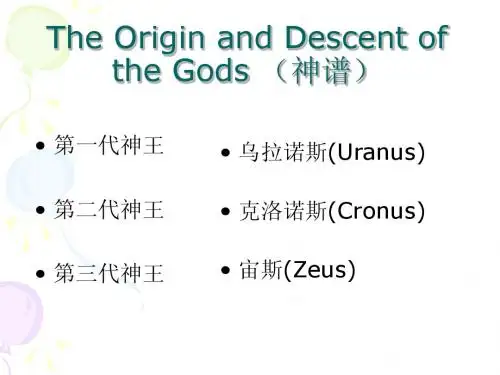


★ 向量、矩阵及其运算法则是描述、分析、处理线性系统的有力工具——其“有力”具体表现在这种工具的普适性和简便性上。
★ 学习基础知识 → 专业课程中进一步认知 → 科学研究中应用第一讲 线性空间与线性变换一、线性空间的定义及性质 [预备知识]★ 集合:集合是数学中最基本的概念之一。
所谓的集合是指一些事物(或者对象,称为元素)组成的整体。
集合的运算:设S 是任意非空集合,如果对任意,x y S ∈,按某种规则规定了S 中的唯一元素z 与,x y 对应,则称这种规则为集合S 的一个(二元运算)。
关键在于运算的封闭性,即z S ∈。
集合的表示:枚举、表达式,如{1,2,5}A =; {1,2,3,...}A =; 2{0}A x x x =+>元素a 属于集合S : a S ∈ 元素a 不属于集合S : a S ∉ 空集: Φ子集:1212()S S a S a S ⊂∈⇒∈真子集:1212,S S S S ⊂≠ 集合相等:1221,S S S S ⊂⊂集合的交集:1212{|}S S x x S x S =∈∈∩且 集合的并集:1212{|}S S x x S x S =∈∈∪或 集合的和集:1212{|}S S x y x S S +=+∈∈,y另外,集合的“和”(+):并不是严格意义上集合的运算,因为它限定了集合中元素须有可加性。
★ 数域:一种数集,含有非零数,对四则运算封闭(除数不为零):任意两数的和、差、积、商的结果仍属于该集合。
比如有理数域、实数域(R )、复数域(C )、四元数域。
实数域和复数域是工程上较常用的两个数域。
线性空间是线性代数最基本的概念之一,也是学习矩阵理论的重要基础。
线性空间的概念是对各种具体线性系统的一种统一的抽象。
1. 线性空间的定义:设V 是一个非空集合,其元素用,,x y z 等表示;P 是一个数域,其元素用,,k l m 等表示。
如果V 满足(I )在V 中定义一个“加法”运算,即当,x y V ∈时,有唯一的“和”x y V +∈(封闭性),且加法运算满足下列性质(1)结合律: ()()x y z x y z ++=++; (2)交换律: x y y x +=+;(3)零元律: 存在零元素0,使0x x +=;(4)负元律: 对于任一元素x V ∈,存在一元素y V ∈,使0x y +=,且称y 为x 的负元素,记为()x −。
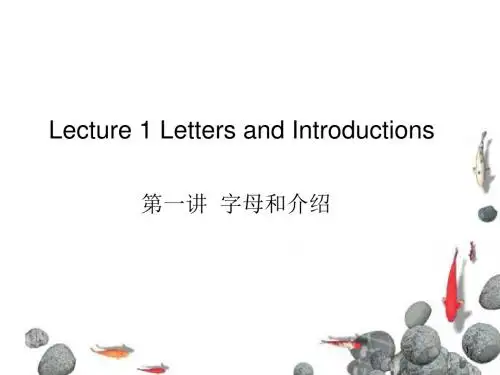
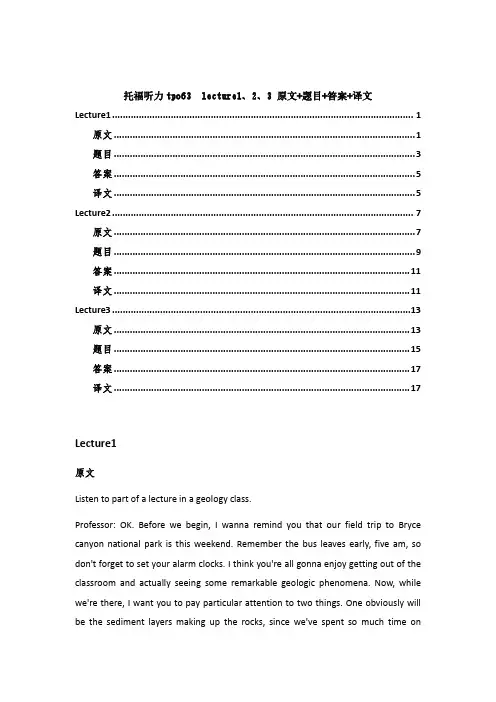
托福听力tpo63lecture1、2、3原文+题目+答案+译文Lecture1 (1)原文 (1)题目 (3)答案 (5)译文 (5)Lecture2 (7)原文 (7)题目 (9)答案 (11)译文 (11)Lecture3 (13)原文 (13)题目 (15)答案 (17)译文 (17)Lecture1原文Listen to part of a lecture in a geology class.Professor:OK.Before we begin,I wanna remind you that our field trip to Bryce canyon national park is this weekend.Remember the bus leaves early,five am,so don't forget to set your alarm clocks.I think you're all gonna enjoy getting out of the classroom and actually seeing some remarkable geologic phenomena.Now,while we're there,I want you to pay particular attention to two things.One obviously will be the sediment layers making up the rocks,since we've spent so much time onsedimentary rocks.Bryce canyon is a great place to see how millions of years have turned layers and layers of tightly packed sediment,mud particles,sand remains of plants and animals into rock.But you're also gonna see some fascinating rock shapes, formations that are the result of the weathering and the erosion processes that occur at Bryce canyon.There are two main processes that are important.The first one is a weathering process called frost wedge.Frost wedge a process that widens cracks in rocks in the wintertime.It begins with warm air or daytime sun melting the snow.As the snow turns into water,it seeps into the cracks that occur naturally in sedimentary rocks.At night,this water freezes in the cracks,but when water freezes,it expands quite a bit, which means that it prize cracks open,gradually,making them wider and breaking off a little bits in the process.Now,this thought freeze cycle can happen as many as two hundred times in a single year.So that makes it the most important weathering process at Bryce canyon.The other key processes is runoff,which is an erosion process.Runoff takes place in the summer.The parks in the desert said the grounds very dry.When it rains in late summer,the ground is too hard to absorb the water,so it runs off.And as it runs off, it carries away the gravel,the broken bits of rock created by cross wedge in the winter.So runoff is the main erosion process that alters the rock landscape in the park.And because these processes have occurred over thousands of years,some of the results can be pretty dramatic,like the giant corridors are passage ways that have developed within the rocks.These passage ways are known as slot canyons.Here's an example of one,not from the part we're going to.This one is actually in Australia,but the scale is typical.So these huge spaces started out as small cracks throughout the sedimentary rock,then thanks to millions of cycles across wedge and runoff.What used to be one big area of rock is now sort of two smaller areas of brought with the corridor in between.We'll have a chance to walk through some like this.These slot canyons are great places to explore,but let me just say,for any of you who aren't from around here,if you ever go on your own,make sure you check aweather forecast first.A sudden heavy rain can cause a flash flood in a slot canyon. So you want to know when it's safe to explore them.Unfortunately,it'll be dry this weekend.Now,these deep,narrow slots are pretty common.You might even have two of them very close to each other with only a thin wall of rock in between.Of course,frost wedge is still at work,so it starts wearing away at the front of the thin wall until you get a whole I mean a hole all the way through the wall,front to back.And this hole gets bigger and bigger.Once it's at least one meter in diameter,it's called a window.And eventually the weight on top of it is just too much,so the roof caves in and only the sides,sometimes it's just one side is left standing.These sides,which look a lot like collins,now are called Hudos.Here's a photo of something we'll be seeing.One of the things that makes Bryce canyon unique is that it has more Hudos than anywhere else in the world.Yes,Margot?Female student:Why is it so lumpy looking?You'd think it would be smoother.Professor:Well,remember,these are sedimentary rocks,so they have layers.Some layers are mostly limestone,and limestone erodes pretty quickly in the presence of any kind of acid.Now Bryce canyon in a very unpolluted area,but even,there the rain water has a little carbolic acid in it,which causes the limestone to erode.But other layers are made up of different types of sediment,which aren't so vulnerable to acid,so they don't erode as quickly.题目1.What is the lecture mainly about?A.The length of time required to produce sedimentary rocksB.The role of climate conditions in the creation of sedimentary rocksC.Some processes that produced a specific group of rock formationsD.Some unique geologic features found in canyons in the United States2.According to the professor,what is one characteristic that frost wedging and runoff share?A.Neither occurs in a desert.B.Neither is a frequent event.C.Both are weathering processes.D.Both are seasonal phenomena.3.Why does the professor show a picture of a slot canyon?A.To give students a sense of the size of a typical slot canyonB.To show students one of the places they will visit on their field tripC.To illustrate how many sediment layers are visible in a typical slot canyonD.To show how much slot canyons can vary based on local climate conditions4.What is the professor's attitude toward students exploring Bryce Canyon on their own?A.He worries that students may not know to take appropriate precautions if they go by themselves.B.He suspects that many students will not go on their own if such a trip requires them to get up early.C.He hopes that the class field trip will motivate students to visit Bryce Canyon on their own.D.He believes that students learn more from individual exploration than they dofrom being in a group.5.How is a hoodoo formed?A.Runoff produces large gravel deposits.B.Air pollution leads to a buildup of limestone.C.The roof of a rock window collapses.D.A flash flood washes away the base of a rock wall.6.According to the professor,what two factors explain why a hoodoo does not have a smooth shape?[Click on2answers.]A.The presence of acid in rainwaterB.The temperature swings between the summer and the winter seasonsC.The composition of the hoodoo's sedimentary layersD.The location of the cracks created by frost wedging答案C D A A C AC译文听一段地质学的讲座。

托福听力tpo56 lecture1、2、3 原文+题目+答案+译文Lecture1 (1)原文 (1)题目 (3)答案 (5)译文 (5)Lecture2 (7)原文 (7)题目 (9)答案 (11)译文 (12)Lecture3 (14)原文 (14)题目 (16)答案 (18)译文 (18)Lecture1原文NARRATOR: Listen to part of a lecture in an art history class.MALE PROFESSOR: OK, at the end of our last class I started to talk a little bit about a dominant movement in United States painting in the late 1940s and the 1950s. And I said that the artists involved shared a spirit of revolt against tradition and a belief in spontaneous freedom of expression. This significant art movement is known as Abstract Expressionism.Now, Abstract Expressionism is kind of hard to define, but it-it’s basically an attemptby the artist to convey meaning or feeling in an abstract way. So, the artists didn’t worry about whether they were painting familiar subject matter, like the kinds of things you’d see in the world around you. They’d paint...well, abstract things, on, ah, a huge canvas—which itself was a break from traditional technique. And it was common among artists to apply the paint to the canvas very rapidly and with great force. So let’s look at the work of the most famous American Abstract Expressionist, Jackson Pollock.There was nothing in Jackson Pollock’s training as an artist that suggested he would come to be seen as some sort of artistic revolutionary. In the 1930s he studied drawing and painting at the Art Students League, a popular art school in New York City. What he did later—in the 1940s—was a startling innovation. Jackson Pollock used a technique, the so called “pour and drip” technique, for which he is best known. He didn’t use the traditional easel—he laid his wall-size canvas flat on the floor, so he could move around it and work it from all sides. Then he poured and dripped his paint onto the canvas without touching it with a brush—just poured and dripped.Now, the physical movements involved in Pollock’s painting technique have led people to call it “action painting,” which almost suggests that the process of creating the painting, physically, was at least as important as the end product itself. In fact, people used to watch him work in his studio, dripping and pouring paint and other materials onto his canvases. This could make you think of Pollock’s work as being kind of like, wild or chaotic, or random. But the truth is that Pollock was in complete control of his materials and his paintings.Pollock’s pour and drip works were quite revolutionary, and at first they shocked the art world. Pollock used massive canvases. They seem more like portable murals than anything else. A good example of his technique is the painting “Autumn Rhythm,” which Pollock painted in 1950.“Autumn Rhythm,” at first glance looks like basically, just a whole lot of squiggly lines;rather bizarre, just like a bunch of pointless drips and swirls. But if you look closely, you see why it’s so admired.Beneath all the apparent chaos there’s really a very definite structure of lines, rhythms, and sensations that makes the whole piece work. Sheer randomness would not be nearly as visually appealing as this painting is. You need some structure, even if it’s not readily apparent.I’ve read some articles by other scholars who’ve, in their discussion of Pollock, um, some of them like to point out that he painted his canvases while looking down at them, since they were on the ground, as I said, but when we go to a museum, they’re up on a wall. They think this is significant because it makes our perspective different. But I mean...well, think of photography. We’ve all seen photos of the sky, the ground...meaning that the photographer was shooting from different angles. Does that mean that we should put a photo of the sky, on the ceiling? Of course not. It wouldn’t matter if you’re looking at it on a wall or in a photo album on your lap. And I think it’s the same with Pollock. It doesn’t matter from which angle we view his paintings. It’s OK that he painted on the floor and we look at it on the wall.But in spite of his work being shocking and even misunderstood at first, Pollock’s work became so influential in the development of Abstract Expressionism, that the artistic community started to shift its attention from Paris, which had been the center of the art world, to New York, where Pollock lived and worked. So Pollock’s breakthrough work helped move the focus of contemporary art, and that’s one of the measures of his greatness, really.题目1.Why does the professor discuss Jackson Pollock?A. To point out a common misconception about Abstract ExpressionismB. To help students understand the nature of Abstract ExpressionismC. To compare Pollock’s technique to that of other Abstract Expressionist paintersD. To defend Pollock and the Abstract Expressionists from criticism2.What point does the professor make about Jackson Pollock’s training as an artist?A. It motivated him to rebel against art he claimed was boring.B. It contrasted with the type of art he later created.C. It taught him how to paint using unconventional methods.D. It was very different from the type of training most artists receive.3.What were two features of Jackson Pollock’s painting technique?[Click on 2 answers.]A. He used walls as a painting surface.B. He painted the canvas while it was on the floor.C. He applied paint by pouring or dripping it.D. He allowed visitors at his studio to help with the painting.4.What is the professor’s attitude toward the term “action painting”?A. He thinks it correctly describes Pollack’s painting technique.B. He considers it less appropriate for Pollock than for other Abstract Expressionists.C. He believes that it represents the sense of movement displayed in Pollock’s paintings.D. He is pleased that contemporary critics rarely use the term.5.What feature of Autumn Rhythm does the professor imply is representative of Pollock’s works?A. It symbolizes the passage of time.B. It reveals a lack of control over emotions.C. It combines structure and the appearance of chaos.D. It combines tradition and innovation.6.Why does the professor discuss photography?A. To emphasize how different it is from paintingB. To make a point about its increasing popularity in New York’s art worldC. To show the extent of Pollock’s influenceD. To support his argument about the way people look at Pollock’s paintings答案B B BC A C D译文旁白:在艺术史课上听一部分讲座。
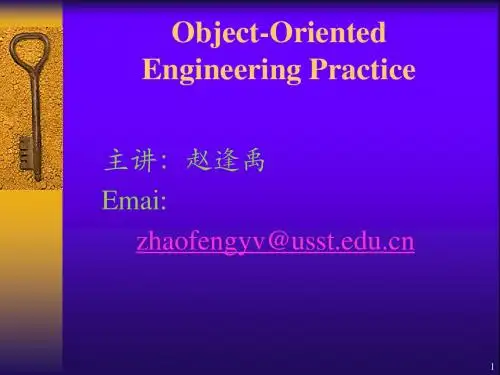


托福听力tpo45 lecture1、2、3、4 原文+题目+答案+译文Lecture1 (2)原文 (2)题目 (4)答案 (6)译文 (6)Lecture2 (7)原文 (7)题目 (10)答案 (12)译文 (12)Lecture3 (15)原文 (15)题目 (17)答案 (19)译文 (19)Lecture4 (21)原文 (21)题目 (24)答案 (26)译文 (26)托福听力tpo45 lecture1、2、3、4 原文+题目+答案+译文Lecture1原文NARRATOR: Listen to part of a lecture in an art history class.MALE PROFESSOR: As I was saying, the Renaissance period—which started in the fourteen hundreds in Europe—the Renaissance was still a pretty religious period. And that's reflected in the artwork of that time.But artists were starting to experiment with a more secular point of view as well—a tendency to also use the natural world as the subject matter for their art.And there were different ways that these natural themes were explored. For instance, many artists would paint portraits, while others—although this was more common in northern Europe—would make landscapes the subject of their works.But today I'd like to consider an influential Italian Renaissance artist, Leon Battista Alberti, who took a slightly different approach.Leon Battista Alberti was a painter, sculptor, architect, musician, poet—very wide-ranging interests—like daVinci or Michelangelo, the sort of guy for whom the term “Renaissance man” was in fact created.Alberti believed that the most important approach for a painter was to capture a story or narrative. Now, as I've indicated, this narrative could be either religious or secular, depending on what the work of art was for. If the work was to be placed in a church then obviously it'd have a religious theme, whereas if it was for someone's home then it could deal with a different subject matter. The exact narrative didn't really matter, so long as it was one that captivated the audience—that held the viewer's attention.So what is actually needed to tell a story?Well, Alberti needed characters, right? Human figures.And he wanted to represent them as realistically as possible to capture the viewer's attention. One way he achieved this was to make use of what's known as the contrapposto pose.A contrapposto pose basically entails showing a slight twist in the body. The shoulders and hips are usually bent in different directions. In other words, if the left shoulder is bent so that it's slightly higher than the right shoulder, then the hips will be bent so that the left side will be slightly lower than the right side. Similarly, in sculptures, most of the weight seems to be on one foot, which also results in this slanted position—making it seem like the figure is about to walk or move. This adds to the realistic aspect of the figure.But there are actually a lot of things that could go wrong in the attempt to create such a pose. You could make a figure’s arms bigger than its legs, or the head too small for the body. Messing up the proportions can leave a figure looking cartoon-like and unnatural. But Alberti had a solution: He encouraged artists to visualize a figure's bones and structure. This would give the artist an idea of the proportions of the figure. From there, Alberti suggested the artist imagine attaching the tendons and muscles, then covering those with flesh and skin.Now, although this method may seem complicated, artists since antiquity have used anatomical observations to try to get the proportions of the human figure as accurate as possible—though obviously not to the degree that Alberti was recommending.Now, in addition to characters, the setting is extremely important, especially when attempting to tell a story realistically. Renaissance artists essentially needed to create a three-dimensional scene on a two-dimensional surface. They accomplished this by the use of perspective—a relatively new idea for artists at the time. In particular, the type of perspective that Alberti advocated was called linear one-point perspective. In fact, Alberti was one of the artists who developed the geometry behind linear one-point perspective.Linear perspective basically consists of drawing straight lines that extend from the forefront of the painting into the background—lines that seem to be parallel to each other, but which actually converge on a single point in the horizon, called the vanishing point. By drawing figures and objects smaller and smaller as the lines get closer together, the artist is able to create depth in a painting. This gives the illusion of a third dimension and makes the work of art more realistic.题目1.What is the lecture mainly about?A. Reasons for the transition from religious to secular themes in Renaissance artB. The disproportionate influence of Italian artists during the Renaissance periodC. Techniques used during the Renaissance to produce realistic works of artD. A comparison of themes in paintings and sculptures during the Renaissance2.What is the professor's opinion of Leon Battista Alberti as an artist?A. Alberti's interests were too diverse for him to succeed in any one field.B. Alberti was ineffective in imposing his own theories on other artists.C. Alberti was a much more skilled artist than da Vinci or Michelangelo.D. Alberti represents the Renaissance ideal of wide-ranging achievement.3.According to the professor, what did Alberti consider to be the most important aspect of a Renaissance painting?A. That it convey an appealing narrativeB. That its figures be posed symmetricallyC. That its theme not be religiousD. That its characters be positioned within a landscape4.Why did some artists begin to use the contrapposto pose?A. To create a cartoon-like effectB. To help viewers identify the main figure in a work of artC. To show the relative sizes of human figuresD. To make human figures appear more natural5.Why does the professor discuss tendons and muscles?A. To emphasize that Alberti's study of anatomy led to his interest in artB. To show the emphasis Alberti placed on using physically fit modelsC. To illustrate the difficulty of maintaining a contrapposto pose in real lifeD. To explain one of Alberti's methods for creating accurate proportions6.Why was the development of linear one-point perspective important to Renaissance artists?A. It helped painters to place figures more symmetrically within their paintings.B. It allowed painters to create an illusion of three dimensions.C. It enabled artists to paint large landscapes for the first time.D. It encouraged artists to take an interest in geometry.答案C D A D D B译文旁白:听一篇艺术史学科讲座。
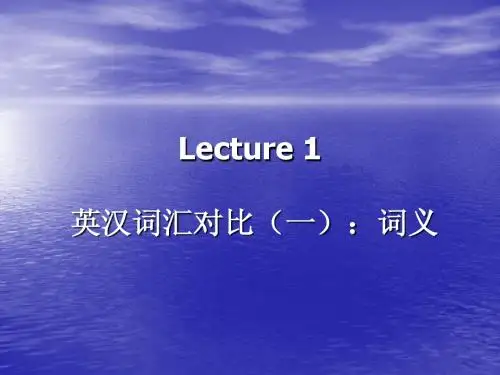
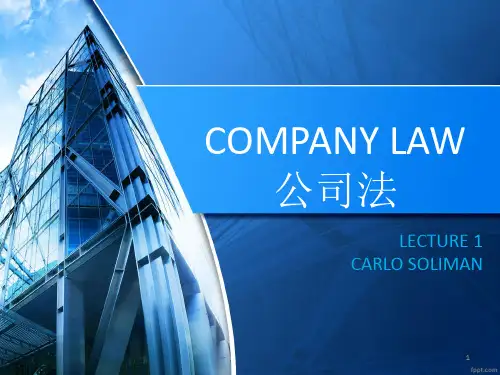
托福听力tpo44lecture1、2、3、4原文+题目+答案+译文Lecture1 (2)原文 (2)题目 (4)答案 (6)译文 (6)Lecture2 (7)原文 (8)题目 (10)答案 (12)译文 (12)Lecture3 (14)原文 (14)题目 (16)答案 (19)译文 (19)Lecture4 (20)原文 (21)题目 (23)答案 (25)译文 (25)Lecture1原文NARRATOR:Listen to part of a lecture in a materials science class.MALE PROFESSOR st time we finished going over some of the fundamental concepts of nanotechnology—the multidisciplinary science of manipulating—or controlling—extremely small units of matter,on the scale of molecules or even atoms.So,I want to talk about how nanotechnology is being used today,and,just to give you an idea,we'll look at one particular application.A team of materials scientists in Massachusetts has been working on a new,ultrathin coating,a nanocoating that might be applied to objects like bathroom mirrors,car windows,and eyeglasses to prevent fogging.And the coating has the potential to be a permanent solution,unlike the kinds of anti-fogging,spray-on liquids that are on the market today...Now,fogging often occurs when a cold surface comes into contact with warm,moist air,such as when a glass shower door or mirror fogs up during a warm shower.…Now,what's actually happening is,uh,what the fog is,is thousands of tiny spherical water droplets condensing on the surface of the glass.Light hits the water droplets and is scattered in random directions,causing the fogging effect.Now,the kind of spray-on treatments I mentioned,well,they wear off.What happens is they cause the tiny water droplets to flatten when they condense on the surface of the shower door,or bathroom mirror,or whatever object it is that it's been applied to.Because the droplets are flattened,when light hits them,the light doesn't scatter. But as I said,those kinds of treatments don't last very long.The new coating has two important components.One:negatively charged silicananoparticles—these are basically tiny particles of glass.And two:a positively charged polymer—which,you already know,a polymer is a chemical compound. These're layered over each other…the polymer,then the silica nanoparticles,the polymer,then the silica nanoparticles,you see.They're layered in such a way that the silica nanoparticles don't pack together tightly.In other words,the structure has pores,or holes,little tiny pockets,throughout it.The coating prevents fog from developing because it loves water.It attracts the water droplets—sucking them into the tiny pores.And that alters the shape of the droplets; the droplets are forced to flatten and to join together into a single sheet of water, rather than remaining as single droplets—each of which is a sphere that scatters light in different directions.OK,so instead of being scattered,the light passes through the thin sheet of water.So there's no fogging effect.The ultrathin coating can be made more durable by heating it—and of course the object it's applied to—to an extremely hot temperature—500degrees Celsius.What that does is burn the polymer away and fuse the silica nanoparticles together—while maintaining the structure of pores.But that's possible only on materials that can withstand high heat.Glass,yes.Plastics, no.But they're working on solving that problem;trying to come up with a way to coat plastics and other materials durably and effectively.Interestingly,it was a plant—the lotus plant—that inspired this work,I guess you could say inspired it in an indirect sort of way.The leaves of this plant are what we call“superhydrophobic.”Lotus leaves,being superhydrophobic,don’t attract water—they repel it—in a big way.When raindrops fall on lotus leaves,they remain spherical.They roll right off.So for a long time the Massachusetts scientists tried to create a coating that acted like these lotus leaves—a coating that was superhydrophobic.But then they began to think about the opposite extreme.Uh,could they accomplish their goal by making acoating that,instead of repelling water,actually attracted water?Well,they seem to have gotten quite far with this approach.It’s really strong work with a range of interesting consumer applications.It's not costly to manufacture the coating.Some car makers are interested in applying it to their windshields.Looks like we'll probably see it on the markets in everyday products in the next few years.题目1.What is the main purpose of the lecture?A.To provide an example of a practical use of nanotechnology.B.To show the origins of the field of nanotechnology.C.To give a brief outline of the main concepts of nanotechnology.D.To explain the growing interest in nanotechnology research.2.How does the professor organize the information he presents to the class?A.He describes the inspiration behind the nanocoating,then how the coating works.B.He describes how the nanocoating is currently marketed,then the inspiration behind it.C.He explains how fogging occurs,then the basic concepts of nanotechnology.D.He explains how fogging occurs,then how the nanocoating prevents it.3.According to the professor,how does the new nanocoating work?A.By forcing light to bounce off a glass-coated polymer.B.By forcing water droplets to roll off an ultrathin surface.C.By causing water droplets to merge into a single sheet of water.D.By causing light to scatter randomly in many directions.4.According to the information in the lecture,why does the new nanocoating not last as long on plastic as it does on glass?A.Plastic cannot withstand extremely high temperatures.B.The internal structure of plastic repels a positively charged polymer.C.The coating solution scatters when it comes into contact with plastic.D.Plastic surfaces scratch more easily than glass surfaces do.5.What inspired the team of scientists in developing the new coating?A.A problem the team frequently encountered in everyday life.B.The ineffectiveness of spray solutions in flattening water droplets.C.The leaves of a plant that the team had been investigating.D.Interactions observed between silica nanoparticles and polymers.6.What is the professor's opinion about the approach inventors took to the development of the new nanocoating?A.He thinks other inventors should use a similar approach.B.He is impressed by the flexibility of their approach.C.He is surprised the research process took so long.D.He thinks they should have spent more time testing a superhydrophobic coating.答案A D C A C B译文旁白:请听一段材料科学的讲座。
托福听力tpo41lecture1、2、3、4原文+题目+答案+译文Lecture1 (2)原文 (2)题目 (4)答案 (5)译文 (6)Lecture2 (7)原文 (7)题目 (9)答案 (11)译文 (12)Lecture3 (13)原文 (13)题目 (16)答案 (18)译文 (18)Lecture4 (20)原文 (20)题目 (22)答案 (24)译文 (24)Lecture1原文FEMALE PROFESSOR:Many organisms have developed the ability to survive in harsh environmental conditions—extreme heat or cold,or,very dry conditions....Like, plants in the desert—your textbook doesn’t have much about the specifics on desert plants,but I think that desert plants are great examples of specialized adaptations to extreme environmental conditions.So with desert plants,there are basically three different adaptive strategies.And I should point out that these strategies are not specific to any particular species—many different species have developed each of the adaptations.So,first off,there are succulent plants.There are many different species of succulent plants,but they all can absorb and store a lot of water.Obviously,opportunities to get water in the desert are few and far between.Generally,rains are light and short,so the rain doesn’t seep too far down into the soil…and there's a limited window of time for any plant to get the water before it evaporates.But succulent plants have a spread-out and shallow root system that can quickly pull in water from the top inch of soil,though the soil has to be saturated,since succulents aren't good at absorbing water from soil that’s only a little moist.Succulent plants also are well suited to retaining water—important in an environment where rainy days are rare.Succulent plants can store water in their leaves,in their stems,or in their roots.And to keep that moisture from evaporating in the hot desert sun,most succulent plants have a waxy outer layer that makes them almost waterproof when their stomates are closed.They also preserve water by minimizing their surface area—the more of the plantthat’s out in the sun,the more potential there is to lose stored-up water—and that means that most succulent plants have few,if any,leaves.Now besides succulent plants,there are also drought-tolerant plants. Drought-tolerant plants are like bears in a way.You know how bears mostly sleep through the winter?They can survive without eating because their metabolism slows down.Well,drought-tolerant plants also go into a dormant state when resources—in their case,water—runs short.A drought-tolerant plant can actually dry out without dying.I said before that most desert rains are light and brief,but occasionally there's a heavy one.Drought-tolerant plants revive after one of these significant rainfalls—and they're able to absorb a good bit of the rainfall due to their deep roots.Actually the root system for drought-tolerant plants is more extensive than the root systems of many plants that live in wetter climates.Drought-tolerant plants can even absorb water from relatively dry soil because of their deep roots,in contrast to succulent plants.The third adaptive strategy is to avoid the drought conditions altogether.Yes,there are plants that do this—annual plants.An annual plant will mature and produce seeds in a single season that will become the next generation of annual plants.In desert conditions,annual plants grow in the fall or spring to avoid the heat of summer and the cold of winter.Of course,these plants could face a serious problem if a particular fall or spring happened to be very dry—they would have difficulty growing and could die before producing seeds.But they have a mechanism to prevent one year of low rainfall from wiping them out. Not all seeds an annual plant puts out will grow the following year.Some seeds remain dormant in the ground for several years.It's a type of insurance that protects the annual plants from a season of poor growing conditions,of unfavorable weather.题目1.What is the lecture mainly about?A.The growth rates of plants in different geographical regionsB.Different ways that plants have adapted to desert environmentsC.The different mechanisms that plant roots use to absorb waterD.Different kinds of succulent plants2.What are two features of succulent plants that help them survive in deserts?[Click on2answers.]A.Succulent plants store water in their leaves and stems.B.Succulent plants become dormant until the next rainfall.C.Succulent plants have short stems.D.Succulent plants have few leaves.3.Why does the professor mention bears?A.To remind students of information from a previous lectureB.To point out a feature common to all desert plantsC.To reinforce a point about drought-tolerant plantsD.To help students understand the concept of adaptation4.What is one ability that drought-tolerant plants have that succulent plants do not have?A.The ability to absorb water from dry soilB.The ability to absorb water through their leavesC.The ability to prevent moisture from being lost through their leavesD.The ability to shed leaves5.Why can annual plants grow in a desert even after a year of no rainfall?A.Annual plants have an extensive root system that can absorb water from far away.B.Annual plants produce seeds all year long.C.Seeds of annual plants can store water for a long time.D.Seeds of annual plants can survive in the ground for a long time without water.5.Listen again to part of the lecture.Then,answer the question.(PROFESSOR)The third adaptive strategy is to avoid the drought conditions altogether.Yes,there are plants that do this.Why does the professor say this: (PROFESSOR)Yes,there are plants that do this.A.To correct a previous statementB.To acknowledge a potentially surprising factC.To anticipate the types of questions that students might have about the topicD.To make sure that students are paying attention答案B ADC AD B译文教授:许多生物已经发展了在恶劣环境中生存的能力:酷热、严寒,或者非常干燥的环境。
托福听力TPO22原文Lecture1下面就让小编来为大家介绍一下托福听力TPO22原文中Lecture1的文本内容吧,大家要好好把握,这些都是非常有价值的材料,同时,大家也可以登录前程百利论坛进行TPO练习辅导,希望能够给准备托福听力的同学带来帮助。
TPO22Lecture1(Anthropology)Professor:One of the big questions when we look at prehistory is why did the earliest statesform?Well,to begin we’d better define exactly what we mean when we talk about states.The human groups that are the smallest and have the least social and political complexity,we call bands.The groups that are the largest and most socially and politically complex,we call states.So,the level of complexity here refers to the organization of people into large,diverse groups,and densely populated communities. And there are four levels in total:bands,tribes,chiefdoms and states.But,but back to my original question. Why did early states form?Why not just continue to live in small groups?Why become more complex? One theory called the environmental approach hypothesizes that the main force behind state formation was population growth.It assumes that centralized management was critical to dealing with issues caused by sudden population surges,like a strain on limited food supplies.At the least complex end of the spectrum, the few families living in bands are able to meet their own basic needs.They usually hunt together and forage whatever foods are available to them,instead of domesticating animals and planting crops.In order to efficiently take advantage of the wild foods available,bands are often nomadic and move around following herds of animals.This strategy is feasible when you have a small population.But when you have a large population,well,the whole population can’t just get up and move to follow a wild herd of animals.So you need sophisticated technologies to produce enough food for everyone.And there is an increase need to resolve social problems that arise as people begin to compete for resources.To manage intensified food production,to collect,store and distribute food,you need centralizeddecision-making,centralized decision-makers.It’s the same thing when it comes to maintaining social order.You need to create and efficiently enforce a formal legal code.It makes sense to have a centralized authority in charge of that,right?So a hierarchy forms.By definition,states had at least three social levels. Usually,an upper class of rulers,a middleclass comprised of managers and merchants,and a lower class of crop producers and agricultural laborers.The environmental approach hypothesizes that states appear in certain environmental settings,settings which have a severe population problem or a shortage of agricultural land.But not everyone agrees with the theory.It definitely has some weaknesses.For example,states have developed in places like the mild lowlands of Mesoamerica and in Egypt’s Nile River Valley. Both places had vast areas of fertile farmland,no shortage of agricultural land.And what about population increase?Well,there were some early states that formed where there wasn’t any sudden population increase.So it seems that these are valid criticisms of the environmental approach.教授:当我们审视史前历史的时候,最大的一个问题就是为何最早的城邦会形成。
托福听力tpo61lecture1、2、3原文+题目+答案+译文Lecture1 (1)原文 (1)题目 (3)答案 (5)译文 (5)Lecture2 (7)原文 (7)题目 (9)答案 (11)译文 (11)Lecture3 (13)原文 (13)题目 (15)答案 (17)译文 (17)Lecture1原文Listen to part of a lecture in a sociology class.Sociology is really a cross disciplinary field.We find that elements of biology, psychology,and other sciences often overlap as we study particular phenomena.So let me introduce a concept from cognitive psychology.Okay,let's say someone asks you to look at a list and memorize as many items on it as you can.Most of us are able to remember,on average,seven items.There are several variations of this memory test.And the results consistently show that the human limit for short term memoryis seven bits of Information.This limit is called channel capacity.Channel capacity is the amount of information that can be transmitted or received over a specific connection,like our brain and the channel capacity for our short-term memory.It has some interesting real-life implications,like phone numbers.Local numbers here in the United States all have seven digits,because the phone companies realized early on that longer numbers would lead to a lot more wrong numbers being dialed.But the idea of channel capacity doesn't apply just to our cognitive abilities.It also affects our relationships with people around us.Psychologists talk about sympathy groups.These are the people,close friends,family to whom we devote the most time.We call or see them frequently,we think about them,worry about them.And studies show for each of us,the size of that group is about10to15people.But why so small?sure.Relationships take time and emotional energy.And most of us don't have unlimited amounts of either.But what if there's another reason?what if it's our brain that setting the limit?And in fact,there's evidence that indicates that our social channel capacity may actually be a function of our brain size,or more accurately,the size of our neocortex.The neocortex is the frontal region in the brain of mammals that's associated with complex thought.Primates have the largest neocortex is among mammals,but among different primate species,humans,apes,baboons, neocortex size varies.A lot of theories have been proposed for these variations.Like maybe it's related to the use of tools,but no theories ever seemed like a perfect explanation.Until the late1990s,what an anthropologist named Robin Dunbar published an article about his studies of primates.Dunbar theory is that if you look at any particular species of primate,you'll find that if it has a larger neocortex that it lives in a larger social group.Take human beings,we have the largest neocortices and we have the largest number of social relationships.So we've said that our sympathy group is10to15people.What about our other relationships other than family and close friends,such as those that occur in the workplace will call these social groups as opposed to sympathy groups?How many relationships can we handle there?Those relationships aren't as involved,so we can handle more of them.But is there an upper limit?well,Dunbar says that there is,and he developed an equation to calculate it.His equation depends on knowing the ratio between the size of the neocortex and the size of the whole brain.That is of the whole brain,what percentage of it is taken up by the neocortex?Once you know the average percentage for any particular species,the equation predicts the expected maximum social group size for that species.For humans,that number seems to be about150. So according to Dunbar’s equation,our social groups probably won't number more than150people.Now,Dunbar’s hypothesis isn't the kind of thing that's easy to confirm in a controlled experiment,but there is anecdotal evidence to support it.As part of his research,Dunbar reviewed historical records for21different traditional hunter gatherer societies.And those records showed that the average number of people in each village was just under150,148.4to be exact.Dunbar also worked with biologists to see if his hypothesis applies to other mammals besides primates. When they looked at meat eating mammals,carnivores,they found that the ones with a larger neocortex also have a bigger social group.And the number of individuals in that group is predicted by Dunbar’s equation supporting his hypothesis. But when they looked at insectivores,mammals that eat insects,the results were inconsistent.The data didn't disprove Dunbar’s hypothesis,but wasn't a nice,neat match like the carnivore studies,which isn't totally surprising.Insectivores are hard to observe,since many of them only come out at night or they spend a lot of time underground.So,we know a lot less about their social relationships.题目1.What is the lecture mainly about?A.The role that the neocortex plays in human memoryB.The connection between neocortex size and social relationships in mammalsC.Various studies that compare social group sizes in humans and other mammalsD.Ways that humans can expand the size of their social groups2.Why does the professor discuss the length of some telephone numbers?A.To show that real-world applications are informed by cognitive psychologyB.To point out an exception to a well-known principle about memoryC.To explain why telephone numbers are used in tests of memoryD.To explain why people often dial the wrong telephone number3.What does the professor imply about the size of a person's sympathy group?A.It closely matches the size of the person's family.B.It becomes larger when a person learns how to feel compassion for others.C.It may not be something a person makes a conscious decision to control.D.It may not be as predictable as the size of the person's social group.4.What did Dunbar's study of the records of some traditional hunter-gatherer societies indicate?A.Hunter-gatherer societies were the first to form social groups.B.Tool usage by humans is related to social group size.C.There is a maximum social group size for humans.D.Hunter-gatherers tend to have smaller-sized social groups.5.What does the professor say that biologists discovered in their research of animals other than primates?A.Dunbar's hypothesis accurately predicts social group sizes for all animals.B.Social group sizes of carnivores are more difficult to predict than those of insectivores.C.Data on insectivore behavior neither support nor contradict Dunbar's hypothesis.D.The size of an animal's neocortex is affected by its diet.6.Why does the professor say this:But why so small?sure.Relationships take time and emotional energy.And most of us don't have unlimited amounts of either.A.To encourage students to spend more time developing relationshipsB.To emphasize that her point is based on personal experienceC.To indicate that she realizes that the students already know the answer to her questionD.To suggest that there is more than one possible response to her question答案B AC C C D译文请听社会学课上的部分内容。
托福听力tpo53lecture1、2、3、4原文+题目+答案+译文Lecture1 (1)原文 (1)题目 (4)答案 (5)译文 (6)Lecture2 (8)原文 (8)题目 (10)答案 (12)译文 (12)Lecture3 (14)原文 (14)题目 (16)答案 (18)译文 (18)Lecture4 (20)原文 (20)题目 (22)答案 (24)译文 (24)Lecture1原文NARRATOR:Listen to part of a lecture in a film studies class.MALE PROFESSOR:Nowadays,we take sound in films for granted—I mean,you stillmight see black and white films occasionally,but you hardly ever see silent films anymore.So it's interesting to note that the use of recorded sound was originally controversial FEMALE STUDENT:What about all the sounds you hear in some silent movies?Like, you know a loud sound when somebody falls down or something?MALE PROFESSOR:OK,you're talking about a soundtrack added much later,which has,over time,become part of the film we know.But this recorded track didn't exist then.And it's not that most people didn't want sound in films;it's just that the technology wasn't available yet.Don't forget that instead of recorded sound there was often live music that accompanied movies in those days—like a piano player or a larger orchestra in the movie theater.Also,think of the stage,the live theater—it has used wonderful sound effects for a long time and,if wanted,these could be produced during the viewing of a film.You know,the rolling of drums for thunder or whatever.But that wasn't as common.Oh,and another thing that they might have in movie theaters in the early days was a group of live actors reading the parts to go along with the film.Or—and this seems a particularly bad idea to us now—one person narrating the action…an early example of a long tradition of movie producers—the ones concerned mostly about making money—not having much confidence in their audience,thinking that people somehow couldn’t follow the events otherwise.So,it finally became possible to play recorded sound as part of the film in the1920s. Trouble was,it wasn't always used to very good effect.First,it was,you know, amazing to see somebody's mouth move at the same time you hear the words…or hear a door close when you see it closing on-screen.But that luster wears off,of course,and if you're a director,a filmmaker,what's the next step?FEMALE STUDENT:Well,use sound to enhance the movie,right?Bring something more to it that wasn't possible…MALE PROFESSOR:Yes,that's exactly what directors who were more interested in cinema as art,not commerce,were thinking.But they also predicted that there would be a problem that sound would be misused, and,boy,was it ever…Because the commercial types,the producers and so on were thinking,OK,now that sound is possible,let's talk as much as possible and forget about the fact that we're making a movie,that we have this powerful visual medium.So,many of the films of the twenties were basically straight adaptations of successful shows from the stage,theater.The name they used for sound films then was"talking films,"and that was on the mark,since,well,all they pretty much did was talk.And talk.So,the remedy?Well,what was proposed by a number of filmmakers and theorists was the creative,expressive use of sound—what they generally called nonsynchronous sound.OK,synchronous sound means basically that what we hear is what we see. Everything on the soundtrack is seen on the screen.And everything was recorded simultaneously,which,well,since the sound technicians working on films often had experience with live radio,that made sense to them.Recording the sound separately and adding it in afterward—well that idea was less obvious.Anyway,synchronous sound means the source of the sound is the image on the screen.Nonsynchronous sound then,is…FEMALE STUDENT:The sound doesn't match the picture?MALE PROFESSOR:Right.Now we can look at this in various ways,but let's take it as literally as possible.Music—unless we see the radio or the orchestra—that's nonsynchronous.If the camera shot is of the listener rather than the speaker,that's nonsynchronous.If wehear,say,background sounds that aren't on the screen—that's nonsynchronous.So,that doesn't seem so radical,does it?But,again,those early producers didn't think their audiences could keep up with this.FEMALE STUDENT:Excuse me,but did you say earlier that some filmmakers actually advocated not using sound at all?MALE PROFESSOR:Well,yes,but that was a bit of an exaggeration,I guess.What I meant to say was that some filmmakers thought that the way the film sound was actually used was setting the art of filmmaking back.But everyone agreed that sound solved some very difficult issues,and offered potentially exciting tools.题目1.What is the lecture mainly about?A.The influence of theater on early sound filmsB.Conflicting views on uses of sound during the early days of sound filmsC.The great progress in cinema after the development of soundD.Viewer reactions to early sound films2.According to the professor,what types of sound were used in silent film theaters? [Click on3answers]A.Live music performed in the theaterB.Sound effects created in the theaterC.Recorded sound tracks played with the filmD.Live narration during the filmE.Musical entertainment offered before the film3.What is the professor's attitude toward early movie producers?A.He is critical of their influence on films.B.He thinks they had little influence on films.C.He thinks they understood what audiences wanted.D.He acknowledges that they made progress possible.4.According to the professor,what was characteristic of sound films in the1920s?A.Dialogues between characters were kept to a minimum.B.Many films were closely based on theater plays.C.Musical sound tracks were added to most films.D.Sounds were recorded separately and added to films later.5.What is an example of synchronous sound in a film?A.A character hearing a train that is not visibleB.A past conversation being replayed in a character's mindC.A character playing guitar and singing on screenD.A song playing at the end of a film as credits appear on the screen答案B ABD A B C译文Narrator:请听一段电影研究讲座的节选。
托福听力tpo65 lecture1、2、3 原文+题目+答案+译文Lecture1 (1)原文 (1)题目 (3)答案 (5)译文 (5)Lecture2 (7)原文 (7)题目 (9)答案 (11)译文 (11)Lecture3 (13)原文 (14)题目 (16)答案 (18)译文 (18)Lecture1原文Listen to part of the lecture in a biology class.Professor: Until about 30 years ago, scientific opinion was pretty much unanimous in thinking that dinosaurs were cold-blooded creatures, and not warm blooded like mammals and birds. What are these terms cold- and warm-blooded mean?Well, they are imprecise terms, a little bit inaccurate, but for the sake of consistency, I’ll continue to use them.Warm-blooded animals, or technically, endothermic animals, are animals that use their own metabolism to maintain a relatively high, generally constant body temperature. They generate their own heat, whereas cold-blooded animals, uh, technically called endothermic animals, cold-blooded animals rely on the environment primarily to regulate their body temperature. And their body temperature can actually vary a great deal depending on the temperaturesurrounding them.Now, as I said, mammals and birds are warm-blooded creatures, and we being mammals, you’re familiar with, you know, your body stays pretty much the same temperature all the time, whereas if you’ve ever seen, say, snakes or lizards you know, basking in the sun on the rock, you can see the characteristic feature of a cold-blooded creature that is using the environment to help regulate its body temperature.As I said, until about 30 years ago, dinosaurs were, because they seem to most closely resemble reptiles, they were thought to be cold-blooded. Then about 30 years ago a number of scientists began to suggest the possibility that dinosaurs might in fact be warm-blooded. This was very exciting for a variety of reasons. Warm-blooded creatures are closer to us. They are more active. They move faster. They can live in a wider range of environments than cold-blooded creatures. So a lot of scientists kind of got on this bandwagon for warm-blooded dinosaurs. But unfortunately, a lot of the evidence for dinosaurs possibly being warm-blooded is indirect. Among the pieces of evidence is that the fossilized remains of dinosaurs have shown that certain kinds of dinosaurs had feathers.Now, feathers in birds, one of their main functions, apart from helping certain birds to fly, is that they are an insulator. They preserve body heat, so by analogy, some people are argued, well, ok, if they were feathered dinosaurs, maybe they had feathers for insulation. Yes, maybe. But maybe not.Another piece of indirect evidence is that some dinosaurs, uh, well, some dinosaur remains have been found in areas, latitudes that today have arctic climates and might in fact had very cold climates at the time that the dinosaurs were living there. It’s hard to function as a cold-blooded creature in an arctic climate. Unfortunately, we don’t have exact climate information. It’s only been suggested that these areas might have been as cold as they are today. So again, this is not, you know, not a knockdown argument in favor of dinosaurs being warm-blooded.Another argument for the warm-blooded theory has to do with looking at the anatomy of dinosaurs and at the similarities with warm-blooded animals. If you look at what’s around today, well, let’s see, today anything that walks on two legs is warm-blooded. That goes for humans and some other primates, and birds like the ostrich, okay? Only warm-blooded creatures, you know, like ostriches, have upright posture.Alright, so proponents of the idea that dinosaurs were warm-blooded say, well, look at dinosaurs, some of them had upright posture too. Coincidence? They say no, these two-legged dinosaurs were warm-blooded too. Okay, but on the other hand, as far as we can tell, dinosaurs lacked a body structure called the respiratory turbinate. Why is that significant?Respiratory turbinate are these complicated structures inside the nasal cavity. They are aligned with soft tissue and their function is that as the air passes through these complicated kinds of curlicue passages, air coming in is warmed up, so that warm-blooded creature isn’t shocked by.. Its lungs aren’t shocked by receiving cold air directly from the outside, which would really disturb its internal temperature. So unless there are some other mechanism that we don’t know about, it seems that these, that dinosaurs lacked this vital feature of all existing warm-blooded animals.题目1.What is the main purpose of the lecture?A. To explain the differences between dinosaurs and modern-day animalsB. To present evidence for a theory that dinosaurs were warm-bloodedC. To describe the body structures of recently discovered dinosaursD. To compare the fossils of warm- and cold-blooded dinosaurs2.There is evidence that some dinosaurs had feathers. According to the professor, why does this support the theory that dinosaurs were warm-blooded?A. Feathers prevented dinosaurs’ body heat from escaping.B. Feathers show that dinosaurs were capable of flight.C. Dinosaurs and birds descended from the same evolutionary ancestor.D. Dinosaurs used feathers to absorb heat from the sun’s rays.3.What does the professor imply about regions that now have arctic climates?A. They can probably support both warm- and cold-blooded modern animals.B. They might have been warmer in the past than they are now.C. They are areas in which dinosaurs were never able to live.D. They are good sources of fossils of feathered dinosaurs.4.Why does the professor mention ostriches?A. To point out that not all birds are able to flyB. To cite evidence that dinosaurs were cold-bloodedC. To show that not all birds have respiratory turbinatesD. To give an example of an animal with upright posture5.What is the professor's opinion of the theory that dinosaurs were warm-blooded?A. It has changed our understanding of the term “warm-blooded.”B. Thirty years ago it was not convincing, but today most evidence supports it.C. It needs more evidence in order to be convincing.D. Most of the evidence we have supports a different theory.6.What does the professor imply when she says this:A. Warming up air may not be as important a function as many scientists believe.B. Cold-blooded animals may use a different mechanism from warm-blooded animals.C. It is possible that dinosaurs had another way to warm up air they breathed.D. Warm-blooded dinosaurs were probably very different from warm-blooded animals today.答案B A B DC C译文请听生物课上的部分内容。